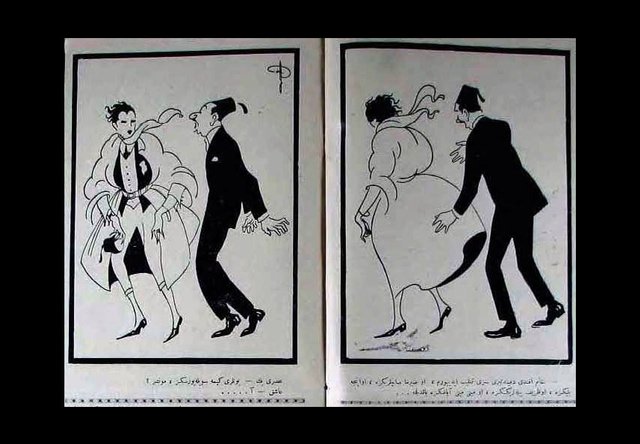127. Today in 1920s Turkey: 17 December 1923 (Stalker Surprise!)

(Cartoon by Ramiz, Akbaba or “Vulture/White-Bearded Old Man,” 17 December 1923, no. 108, pages 2 and 3.)
English:
(right) — Ma’am I have been following you for quite a bit and as I behold your golden locks of hair, your thing waiste, your delicate bracelet, your itty bitty feet…
(left) Modern man: Who are you saying these (things) to, Monsieur?
Love-struck man: Uh…
Türkçe:
(sağ) — Hanım efendi deminden beri sizi takip ediyorum, o sırma saçlarınıza, o ince belinize, o zarif bileziğinize, o mini mini ayağınıza baktıkça…
(sol) Asri Bey: Bunları kime söylüyorsunuz, mösyö?
Aşık: A…
Comments
Split between two pages, this dual-frame cartoon reads from right to left, like the Ottoman script. The two-part visual trick played on the viewer by the artist is obvious even to those who cannot read the text below which simply adds a bit of narrative. Here, we witness the unexpected faux pas of a the man wearing a black suit as he approaches the person in the white billowing coat—a person he had only seen from behind. So easily enticed and without even bothering to look at the person’s front end, the overly-enthusiastic romancer begins declaring his attraction to long list of “her” physical attributes. In the second frame the “love stricken” man’s surprised demeanor is revealed when (we are all collectively) exposed to the real, male identity of his “thin-waisted” beloved.
Although not essential, the text adds an element of social commentary by identifying the person who was mistaken for a woman as a “Modern man” which serves to associate traditionally effeminate physical attributes (small feet, tiny waiste, long ringlets of hair) and accessories (bracelet) specifically with those of the modern man. Of course, much like today’s rhetoric of macho vs effeminate men, there is the unspoken socio-economic distinctions that come with men who are “style conscious” versus “functional” dressers. In a great many cartoons of this period the modern man is also envisioned as an overly sophisticated, preppy dandy. But neither the trope of the gender misidentification nor the type of the dandy (or modern man) is novel in Turkish culture or literature. For instance, Karagöz and Hacivat shadow theater, a traditional urban form of coffeehouse entertainment that dates back centuries, included a story of the main character (Karagöz) dressing like a woman and almost joining the neighborhood drunkard (named Crazy Bekir the Saltless or Tuzsuz Deli Bekir) in holy matrimony. The Karagöz theater tradition also included a recurring character, the Dandy (Çelebi) who lived off of his father’s money, dressed in the finest clothes, enjoyed a life of leisure, and was popular with the ladies—clearly he is a protégé to the delicate “modern man” type seen in today’s cartoon.
This is not the first cartoon of its kind by artist, Ramiz. Today in 1920s Turkey has covered several works by Ramiz whereby a similar “reveal” occurs. For instance, post #59 (A Cross-Dresser’s Journey) focuses a seven-frame “strip” by Ramiz in which a plump woman “strips” down from her layers of clothes and accessories to reveal the truth that a skinny man is actually underneath. Besides showing the various formal parallels possible between male-female binaries, Ramiz is also interested in other visual transformations. In a recent post, #122 (What the Shadows Convey), a cartoon by Ramiz explores the deceptive potentials of shadows when compared to “reality” (or vice versa). Other examples follow the above multi-frame format. Post #61 (New "Film" Starring Charlie Chaplin and Harold Lloyd) deploys a film-frame-esque composition to outline a vision-based situational mistake starring the two famous comedic actors (think Elmer Fudd vs. Bugs Bunny). In another form-bending strip of images, Ramiz compares love-making to competitive wrestling (#54, A Clever Cartoon of Combat and Courtship)—demonstrating one more example of the kind of binary-parallels (seemingly opposites) that Ramiz so enjoys “drawing.”

(Entire double-page spread, Akbaba or “Vulture/White-Bearded Old Man,” 17 December 1923, no. 108, pages 2 and 3.)